18-19 December 2010
Saturday 18 th December Attendance: 2 With most of England in winters grip their had been numerous heavy snowfalls and this had made the prospect of travelling to Bury to work on the locos a daunting one, there had been around 5 working members intending to attend but as further snowfalls on the Friday night and early Saturday morning in North Lancashire, East Wales and Staffordshire it had prevented most from setting off however one working member was fortunate enough to find a window through the weather and Jason arrived at Baron St just after 9am to find the works yard 4-5 inches deep in show, after getting sorted out and walking to the local corner shop for breakfast he went down to the loco and had a specific task in mind to remove the Exhaust system from the R/H side of the engine so as to get the engine ready for preparations for painting. After untying the tarp down the right hand side of the loco he noticed that their was a minor oil spillage on the front part of the sole bar running board, this had seeped out from a minor oil leak in the cooler group during run up of the engine in July, so Jason got some rags and mopped it up, the next task was to remove three of the body side doors that would get in the way of work so after propping the tarp up with a metal pole Jason carefully lifted each door off it hinges and lowered them to the ground, he then fetched a wheel barrow from the steam department and using that that he tripped each door up to Paddy (the Irish Thumper power car) and opened the door and leaned them up neatly inside before locking paddy back up again, with the doors out the way Jason had easy access to the R/H side of the engine and the exhaust. He set up the three bar halogen heater on the running board next to him and a lead light before fetching down a load of 14mm & 9/16 th sockets and spanners that he would use to undue all the exhaust bolts, after taking some reference photos of the exhaust in situ he began to dismantle it starting at the front section, with experience he had gained from removing and refitting the L/H side exhaust he decided to remove the manifolds in as complete form as possible without separating the pipes into their individual sections, with this in mind he began unbolting the cylinder head flanges on manifold branches 2 & 3 as some of the bolts were a little difficult to get onto due to the exhaust lagging flanges a bit of creativity was required to get access and a couple of custom tools for the job needed to be fashioned like grinding down to open end of a spanner to make it narrower so it would fit easier and allow for a greater throw, branch 2 came off first with a little twist to the end pipe and that gave access to the 3 rd branch, the 1 st branch then soon followed suit being a little stubborn to pull the ring joint out of the intermediate cooling knuckle, that leaving branch 4 which connects to cylinders 4 & 5, this is bolted to the knuckle so the back bolt was tight to get onto, with a slight twist of the manifold the cut down spanner came into play and the removal of the front section was completed before lunch. While Jason was doing all this Alan Lee had turned up and around 11:30, Jason was supposed to have helped him move one of the large air tanks from the Co-bo tent upto Castlecroft using Alan's van but as it was showed in at Castlecroft yard he had come down on foot and went onto the class 14 to carry on with his electrical work and crimping up the terminal ends on the wiring, he continued this work until around 15:30 before he had to depart. After lunch Jason went back to the 15 and set about removing the rear section, as the pipe flange joints onto the Turbo knuckle had already been taken apart when the turbo was removed for the refitting of the Generator cleaned up and put back together for the start-up he decided to take these bolts out first as they were clean and not rusted up, that done he started working his way towards the front of the engine taking out the head flange bolts that is until he came to one on Cylinder head No. 6 that was impossible to get one with a spanner or socket due to the bend of the pipe and a close lagging flange, it did however have a straight screwdriver slot cut into its head so on getting a large screwdriver and by wiggling the manifold assembly it started to move… it was at this point however he realised that the whole of the back section of the exhaust was now held up by this one bolt, and once it was removed it would crash to the floor due to its weight, so he went back to the coach and got a ratchet strap and looped it around the top branch and the handrail along side the roof, by ratcheting up the take the weight of the manifolds he was able to undue the last bold and when it came out gently lower the assembly down until it was hanging from the strap where by he could get access to the obscured bolts and dismantle branches 3 & 4 before slowly lowering the rest down to the deck, after this he carried the exhaust pipes back to the support coach and stored them in the workshop for the time being, after picking up the tools and tying the tarp back down that ended the days work. Sunday 19 th December Attendance: 1 Jason awoke to a bright sunny yet cold day, his first task today was to do a spot of painting inside the cab, when the cab and been refitted back unto the loco it was placed over the cable duct that runs under the cab, this has been fully repaired and painted but the floor section under it had only been painted with welding primer as we had not decided whether to bolt or weld the duct to the floor, in the end it was bolted down but the floor remained unpainted, after making sure that his paint tins had been in the warmth over night he set up the halogen heater up in the cab and started painting, he painted the black floor line up to the outside end of the ducts first, the smaller duct to the No. 2 end master controller stand is also bolted down but is removable so that was lifted to allow painting to be done, after painting the black edges in the cab Jason moved into the No. 2 end and blacked the edges in there after which he got the anti-tracking paint and blathered it around on the floor inside the duct, after the No. 2 section was done he moved back into the cab not before getting a couple of dust sheets and covering over the Compressor and Traction motor blower in there, back in the cab he redded the floor print of the auxiliary duct before redding the floor print of the main cable duct and as an addition he also painted the insides of the controller stands with anti-track, then to finish the task off he went into the generator compartment and redded the floor section inside the buzz-bar box just under the generator terminals. After this he relocated to the engine compartment and set up the needle gunning equipment, deciding the start at the top and work his way down he began gunning on the front top edge of the inlet manifold and worked his way along to top until he reached the turbo inlet pipe at the rear, by then it was time for lunch so he stopped for food after which he when back to the front of the engine to start gunning the underside of the inlet manifold, it was then that he noticed the engine instrument panel that had been fitted to the engine when it was converted to a stand-by generator set, it was fitted where the load regulator box should be and as its no longer needed its due for removal, so Jason decided that now was the time to do it, he first carefully checked what pipes and wires were connected to it and disconnected them. He had to remove the temperature sensor from the thermostat housing so as to keep it with the gauge mounted into the panel, then after removing the two bolts the panel was off leaving room behind to access the front of the inlet manifold for gunning. With the way now clear Jason gunned he way back down the manifold working around the inlet branch droppers and going over the exhaust flange faces, upon reaching the end it was mid afternoon and time to start packing things away for a early departure, he took the tools and the removed control panel back to the coach and tried the tarp back onto the loco, a quick tidy up in the support coach to make sure that everything was put away and switch off before locking up and setting off for the long journey home, so ends another year on Project D8233, its been a big year for the loco with huge strides and milestones made, but as ever the work continues, a big Thank You goes out to everyone who has assisted with the restorations of D8233 and D5705 & D9531 we look forward to further progress in 2011. The next working weekend is 8/9 January. If you wish to lend a hand please contact Chris Tatton |
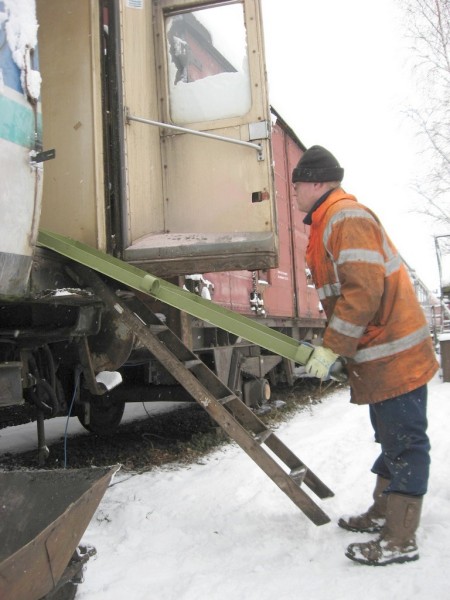 |
| Above : After removing the R/H body side doors Jason is seen pushing on up into the door of "Paddy". © C15PS |
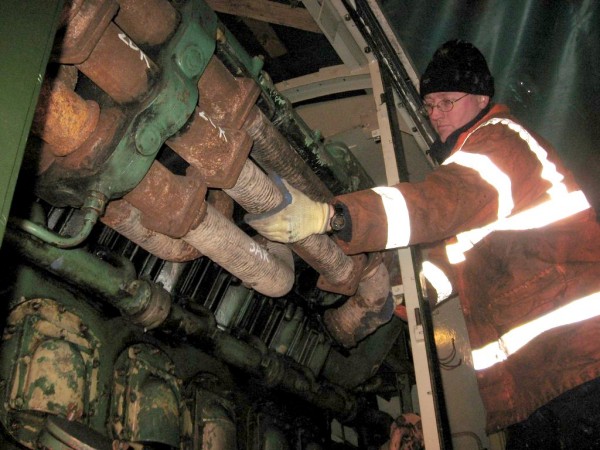 |
| Above :
Jason is in the process of removing the first scetion of exhaust manifold from the R/H side of the engine . © C15PS |
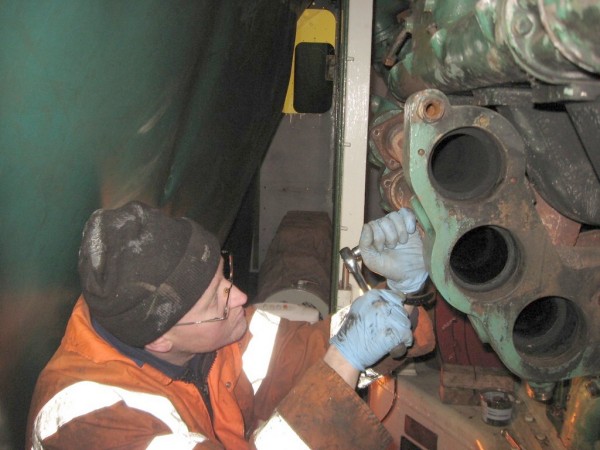 |
| Above : After lunch Jason begain unbolting of the rear section of the exhaust assembly. © C15PS |
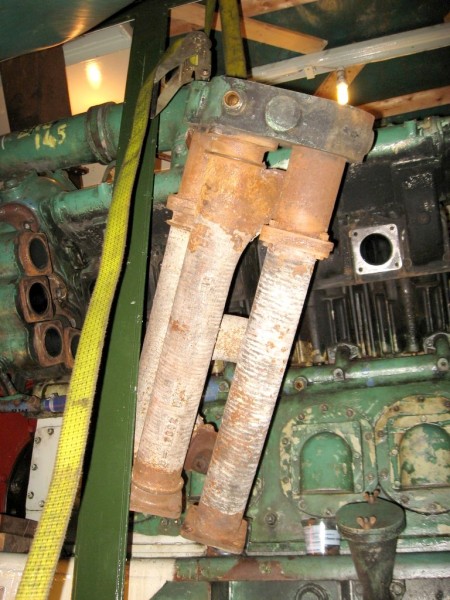 |
| Above : Just after the last bolt was removed the complete rear exhaust assembly is seen hanging from the support strap. © C15PS |
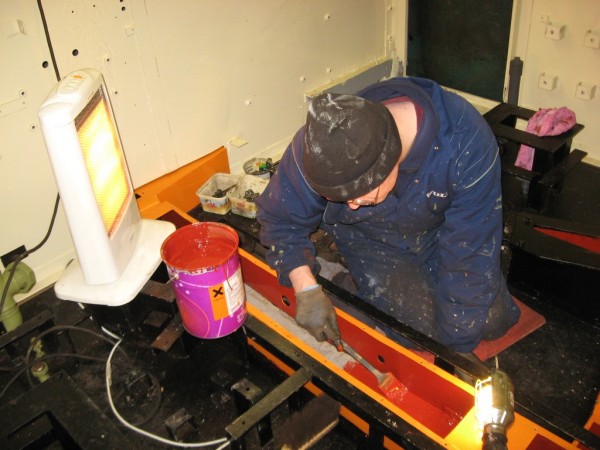 |
| Above :
First thing sunday morning Jason is seen applying anti-tracking paint to the inside of the cab cable duct. © C15PS |
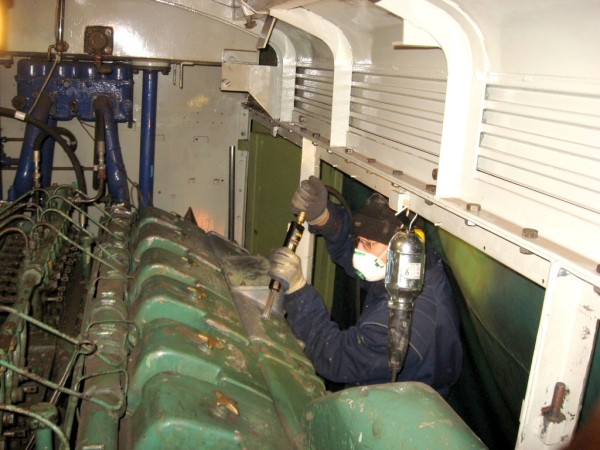 |
| Above :
With the Exhaust removed Jason could start needle gunning the inlet manifold in preperation for painting. © C15PS |
Fancy Getting Involved? click on the You Can Help page